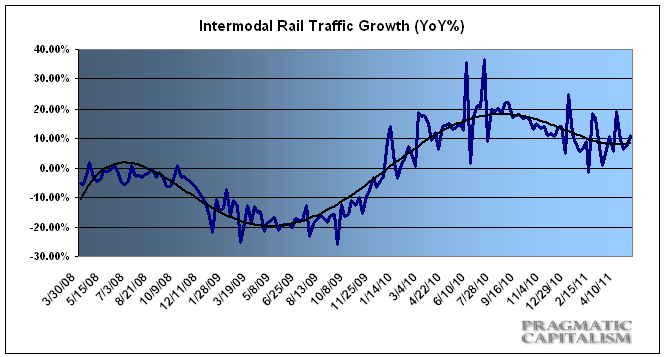Rail data was a bit mixed again this week with the AAR reporting small gains in carloads and a rebound in intermodal traffic (via AAR):
“The Association of American Railroads (AAR) today reported mixed results in weekly rail traffic with U.S. railroads originating 281,860 carloads for the week ending May 7, 2011, down 2.6 percent compared with the same week last year. Intermodal volume for the week totaled 232,178 trailers and containers, up 11.2 percent compared with the same week in 2010.
Six of the 20 carload commodity groups posted increases from the comparable week in 2010. Commodity groups posting significant increases are grain, up 19.9 percent, and metals and products, up 13.1 percent. Groups posting a notable decrease are: primary forest products, down 19.5 percent; nonmetallic minerals, down 16.3 percent, and waste and nonferrous scrap, down 13.7 percent.
Weekly carload volume on Eastern railroads was down 0.1 percent compared with the same week last year. In the West, weekly carload volume was down 4.2 percent compared with the same week in 2010.
For the first 18 weeks of 2011, U.S. railroads reported cumulative volume of 5,233,086 carloads, up 3.4 percent from last year, and 4,002,923 trailers and containers, up 8.9 percent from the same point in 2010.”

Mr. Roche is the Founder and Chief Investment Officer of Discipline Funds.Discipline Funds is a low fee financial advisory firm with a focus on helping people be more disciplined with their finances.
He is also the author of Pragmatic Capitalism: What Every Investor Needs to Understand About Money and Finance, Understanding the Modern Monetary System and Understanding Modern Portfolio Construction.
